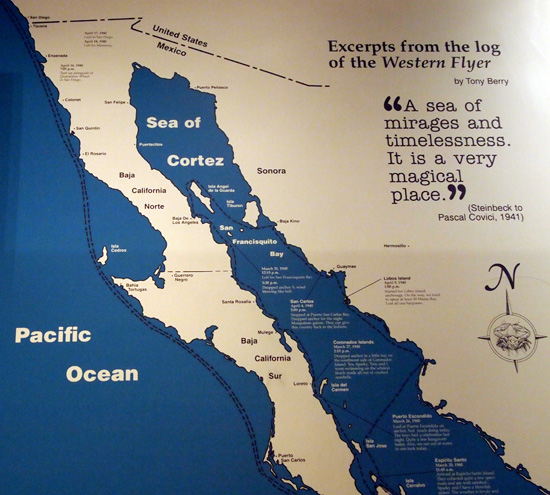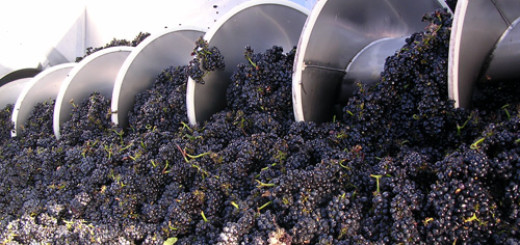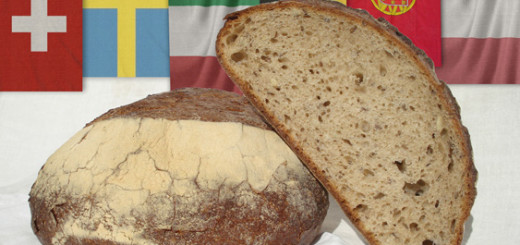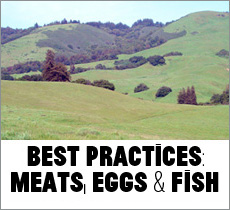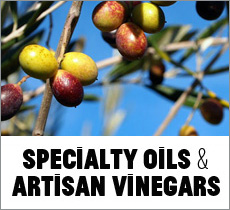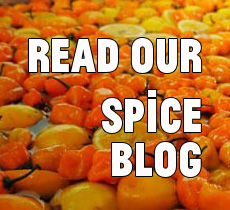Los Braceros: The Root of the Gourmet Kitchen
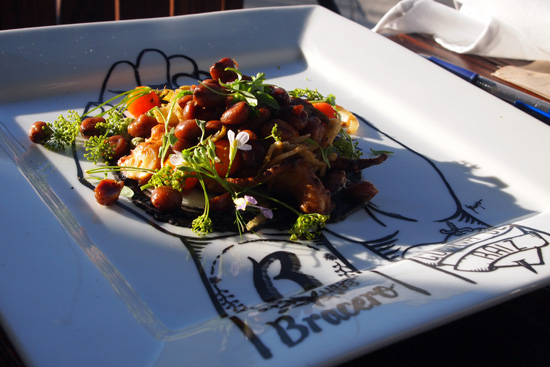
WOOD GRILLED OCTOPUS: black bean & squid ink sauce / achiote / green garbanzo / habanero-peanut salsa
The octopus arrived at our table on a plate illustrated with the two hands of the many workers who helped produce this gorgeous dish. At Bracero Cocina de Raiz in San Diego, Baja cuisine advocate Chef Javier Plascencia invites guests to witness and celebrate the efforts of all the workers—including produce pickers, grapevine pruners, and fishermen—who help them produce such incredibly creative and flavorful dishes in a Mexican style completely their own.

ALBACORE TWO WAYS / SEARED / TARTARE: lime salsa verde / crispy rice cakes / burnt onion crème fraiche / crispy eggplant / jalapeño infused leche de tigre
Bracero Cocina cuisine knits together Baja and California as well as Mexico’s culinary past and present. Every dish that arrived at our table lured the adventurous foodie to embrace this deliciously different Baja-centric cuisine.
A transformative sauce: smoky creamy burnt onion with crème fraîche that hosted edible sculptures of albacore. Fresh, unique flavors for my 45-year-old palate? Yes please!
Bracero Cocina encourages guests to delight in the final dish without forgetting how the collective ingredients traveled from field and ocean to wineglass and plate. It’s happily impossible to ignore the provenance of one’s food at this exciting restaurant.
Hecho en Mexico:
Baja Haute Cuisine
Outstanding ingredients don’t land in a chef’s hands out of nowhere: Bracero Cocina honors the fact that they simply could not create anything without the humble field worker. A serial restauranteur in San Diego, Tijuana, and further south into the heart of the edible Baja landscape, Chef Javier knows that field workers—Mexican braceros—are the root or raiz of every cocina, from their newest restaurant to the kitchen in your home and mine. Rustic bracero decor abounds throughout this slick new space in Little Italy, a “must visit” when foodies find themselves in Southern California.

Chef Javier Plascencia
The warmth and openness of Javier Plascencia belies his status as a celebrity chef, culinary friend of the Monterey Bay Aquarium, and subject of a glowing profile in The New Yorker for reinvigorating his home town of Tijuana through delicious food. In June 2015, we met in Monterey with Chef Javier and our friends from the Salinas Underground Podcast to discuss how to turn the tide of negativity about one’s hometown through seductive, delicious food. And a popular soccer team.
Proud to Produce Produce
During the interview, I kept thinking of Frida’s Fiestas and Frida Kahlo’s intense national pride demonstrating itself through culinary creations she produced during happier days with painter Diego Riviera and his daughter Guadalupe in their Mexico City home Casa Azul. Frida Kahlo and Javier Plascencia both model Mexican culinary and cultural excellence through generous, exceptional food.
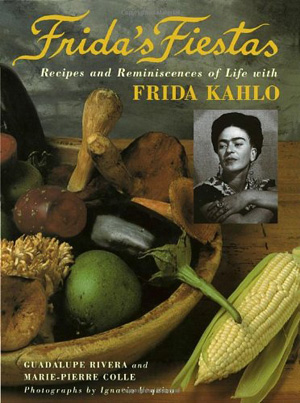 Chef Javier’s intellectually rich early 21st century restaurant fare links to Frida Kahlo’s intricate and meaningful early 20th century private meals through metate, knife, and fire. Likewise, her recipes connect through ingredient and process to earlier generations who developed and cultivated the agricultural Mexico that eventually came to supply her own kitchen. She chose to cook with ingredients linked to the soul of her country just as Chef Javier chooses to prepare food with ingredients sourced from Baja California, including wines and produce from Valle de Guadalupe, the site of another of his restaurants, the pastoral Finca Altozano. The artistry of food and drink, connecting us through distance and time.
Chef Javier’s intellectually rich early 21st century restaurant fare links to Frida Kahlo’s intricate and meaningful early 20th century private meals through metate, knife, and fire. Likewise, her recipes connect through ingredient and process to earlier generations who developed and cultivated the agricultural Mexico that eventually came to supply her own kitchen. She chose to cook with ingredients linked to the soul of her country just as Chef Javier chooses to prepare food with ingredients sourced from Baja California, including wines and produce from Valle de Guadalupe, the site of another of his restaurants, the pastoral Finca Altozano. The artistry of food and drink, connecting us through distance and time.
Our friend Osbaldo Lucero with the Salinas Underground Podcast has observed how, instead of feeling embarrassed about one’s farm worker background with dirt under the fingernails, people from Salinas should be proud to know they grow the vegetables and fruits that keep everyone fed and healthy. They are not a social nuisance as perhaps some wealthy right wing socialite might feel after over indulging on a Fox News fathead feast.
While that conservative woman eats her green salad to stay trim and healthy, I wonder if she thinks of the field workers, laboring in 95° temperatures at the end of August to harvest her romaine. As Oz observes, “They need that person bending over at the waist, picking their lettuce.” Farm workers are a social good for enhancing the health of the individual and the country at large.
A subject matter expert in the growing of backyard edible plants including tomatoes and peppers, Oz himself seemed to take for granted initially how naturally easy it has been for him to grow some of his own food. As a Salinas native, produce producing skills are in his blood as they are for many current residents and descendants of family who came from the agricultural regions of Mexico to this key agricultural area in California.
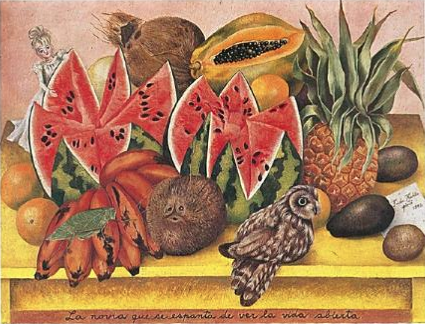
Still Life with Watermelons, Fruit, Animals and Fairy by Frida Kahlo
Oz also gives props to the perfect growing conditions of the Salinas Valley: “In this climate, we could literally throw seeds on the ground and they would grow.” On their social and critical commentary podcast considering the experience of being from their hometown, Team SUP—like the folks at Bracero Cocina—work to reclaim and, indeed, assert a place of honor for those who feed the country by expertly producing healthy produce.
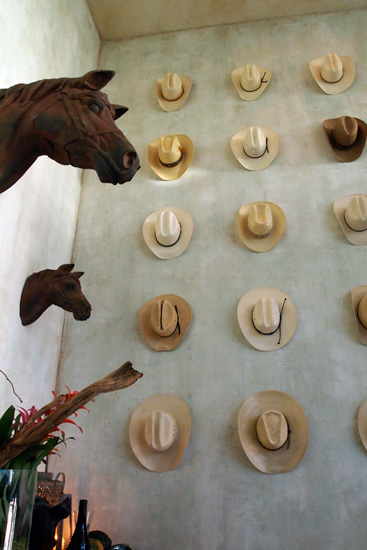
El Cortito, Hands Free
On the second floor of Chef Javier’s handsome restaurant space, a compelling animatronic sculpture featuring the short-handled hoe—el cortito—moves rhythmically while cultivating air. These body warping tools for farm work were outlawed in 1975 after a long fight to ban them due to the debilitating pain they caused for the people who used them to harvest the food we eat. At the Steinbeck Center in Salinas, one can learn more about el cortito but only by stooping into the same position as the workers who wielded this too-short cultivation tool. When I bent down to read the interpretive placard, I was only in this awkward position for a few seconds, not the many painful hours required of hardworking farmworkers.
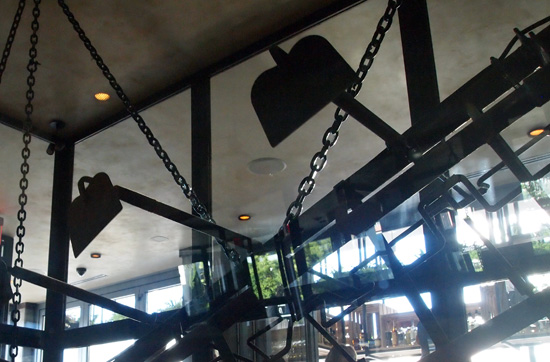
El cortito sculpture at Bracero Cocina
Braceros or Mexican field workers first came to the US during World War II to help harvest crops when American farmers and their farmhands went off to fight in Europe and the Pacific. Many of them worked in Salinas, California, where they helped turn pasture and grasslands into productive fields. With the work of their hands and the awkward, inadequate el cortito, these field workers helped feed everyone, including our troops via military rations as well as their families left behind.
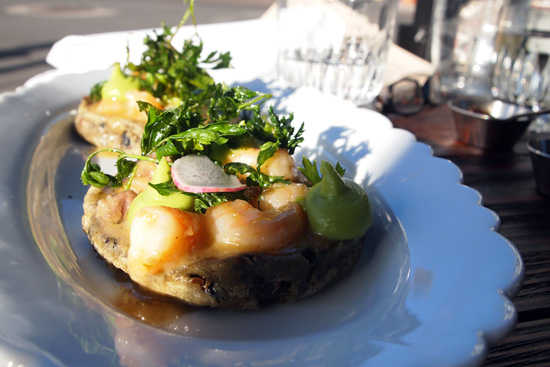
SHRIMP & BONE MARROW SOPES: fried parsley / chile de árbol
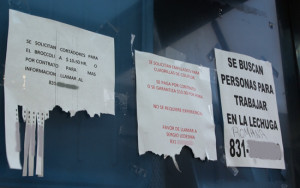 Today, field workers continue to help supply the US with harvested produce, although it’s more difficult for growers to find enough workers in agricultural regions across the country to pick vegetables given the recent expansion of xenophobic hostility from the stupider slice of America. While recording our first Food Truck Finds episode in June 2015 on the east side of Salinas, our friends with the Salinas Underground Podcast pointed out that they have never seen ads for lettuce pickers and the like posted on the outside of a food truck. Someone tell our angry anti-immigrant fellow Americans that their lettuce picking jobs are waiting for them in Salinas.
Today, field workers continue to help supply the US with harvested produce, although it’s more difficult for growers to find enough workers in agricultural regions across the country to pick vegetables given the recent expansion of xenophobic hostility from the stupider slice of America. While recording our first Food Truck Finds episode in June 2015 on the east side of Salinas, our friends with the Salinas Underground Podcast pointed out that they have never seen ads for lettuce pickers and the like posted on the outside of a food truck. Someone tell our angry anti-immigrant fellow Americans that their lettuce picking jobs are waiting for them in Salinas.
Verde Es Vida en Baja California
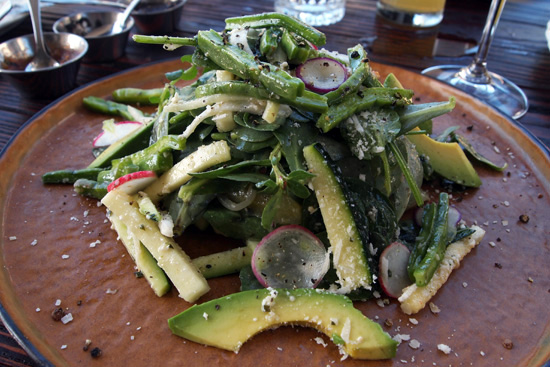
VERDE ES VIDA SALAD: salt-cured cactus / watercress / bloomsdale spinach / zucchini / chayote squash / purslane / mexican oregano vinaigrette / avocado / 18 month aged cotija
During a recent trip to San Diego for a family reunion, Mr. Spice and I peeled off to enjoy an evening with just the two of us at this highly anticipated restaurant. Our outstanding meal crafted with local produce from both sides of the border whetted our appetite to explore the Baja landscape that inspires this extra creative chef. Two beautiful ladies (and Chef Javier groupies) who dined at another table invited us to join them at Finca Altozano when we next returned south and followed our palates and stomachs into the Valle de Guadalupe along la Ruta del Vino. ¡Volveremos, seguro!
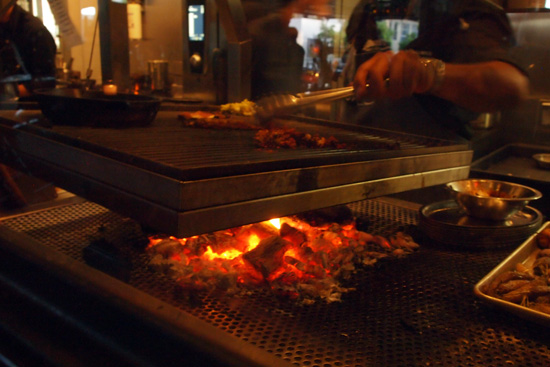
Chef Javier at the grill with octopus
As we drove north back to San Luis Obispo County, Mr. Spice noted how the smiling photo I captured of Chef Javier might be enhanced to look like a painting created by one of Mexico’s famous muralists from the early 20th century. We had learned about Diego Rivera, David Alfaro Siqueiros, and José Clemente Orozco in a Spanish language program and remain intrigued by the arts of Mexico. We feel Chef Javier’s generosity and humanism as well as his culturally grounded artwork with food and drink would have made him a good subject for Orozco.
Travel + Food + Drink = YES!

from _Log to the Sea of Cortez_ by John Steinbeck and Ed Ricketts
From Peru to the California Central Coast, Mr. Spice and I have always enjoyed travel inspired by delicious food. Chef’s signature ingredient of octopus is prepared in different ways at his various restaurants: we’re now on a pulpo foodie scavenger hunt. Stay tuned…

